
The Chilean flamingo is a species of large flamingo at a height of 110–130 cm (43–51 in) closely related to the American flamingo and the greater flamingo, with which it was sometimes considered conspecific. The species is listed as Near Threatened by the IUCN.

The Valdivian temperate forests (NT0404) is an ecoregion on the west coast of southern South America, in Chile and Argentina. It is part of the Neotropical realm. The forests are named after the city of Valdivia. The Valdivian temperate rainforests are characterized by their dense understories of bamboos, ferns, and for being mostly dominated by evergreen angiosperm trees with some deciduous specimens, though conifer trees are also common.
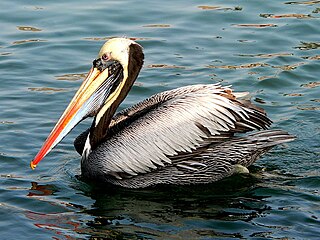
The Peruvian pelican is a member of the pelican family. It lives on the west coast of South America, breeding in loose colonies from about 33.5 degrees south in central Chile to Piura in northern Peru, and occurring as a visitor in southern Chile and Ecuador. It used to be considered a subspecies of the brown pelican.
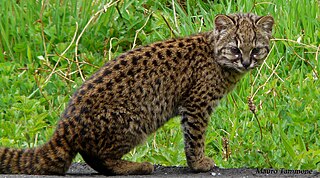
The kodkod, also called güiña, is the smallest felid species native to the Americas. It lives primarily in central and southern Chile, as well as marginally in adjoining areas of Argentina. Since 2002, it has been listed as Vulnerable on the IUCN Red List as the total population may be less than 10,000 mature individuals; it is threatened by persecution, and habitat loss and prey base.
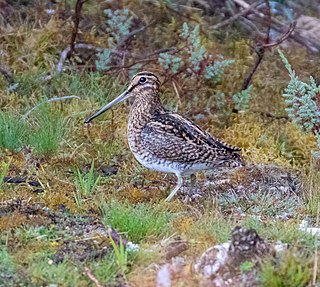
The puna snipe is a bird in tribe Scolopancinai and subfamily Scolopacinae of family Scolopacidae, the sandpipers and relatives. It is found in Argentina, Bolivia, Chile, and Peru.

The striped woodpecker is a species of bird in subfamily Picinae of the woodpecker family Picidae. It is found in Argentina, Bolivia, and Chile.

Vicente Pérez Rosales National Park is located in Los Lagos Region, Llanquihue Province, of Chile. Its western entrance is close to the Ensenada locality, 82 km (51 mi) northeast of the provincial capital of Puerto Montt, and 64 km (40 mi) from Puerto Varas along Ruta CH-225. This national park covers about 2,530 km2 (977 sq mi) and is almost entirely in the Andes mountain chain. The adjacent national parks Vicente Pérez Rosales and Puyehue National Park in Chile, and Nahuel Huapi National Park and Lanín National Park in Argentina, provide a continuous protected area of close to 15,000 km2 (5,792 sq mi).

Queulat National Park is a national park of Chile located in the Aysén del General Carlos Ibáñez del Campo Region. The park is bordered by the Cisnes River on the south side and is neighbor to Lago Rosselot National Reserve. It contains 1,541 km2 (595 sq mi) of glacier-capped mountains and virgin evergreen forests.
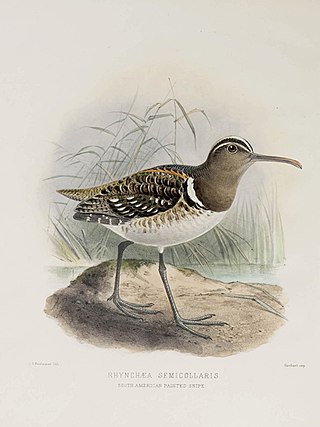
The South American painted-snipe, or lesser painted-snipe, is a shorebird in the family Rostratulidae. There are two other species in its family, the Australian painted-snipe and the greater painted-snipe.

The nacunda nighthawk is a species of nightjar in the family Caprimulgidae. It is found in Argentina, Bolivia, Brazil, Chile, Colombia, Ecuador, French Guiana, Guyana, Paraguay, Peru, Suriname, Trinidad and Tobago, Uruguay, and Venezuela. Its natural habitats are dry savanna, subtropical or tropical seasonally wet or flooded lowland grassland, and heavily degraded former forest.

The two-banded plover is a species of bird in subfamily Charadriinae of family Charadriidae. It is found in Argentina, Brazil, Chile, the Falkland Islands, and Uruguay.

The austral rail is a Vulnerable species of bird in subfamily Rallinae of family Rallidae, the rails, gallinules, and coots. It is found in Argentina and Chile.

The grey-cheeked fulvetta or Morrison's fulvetta is a bird in the family Alcippeidae. The species was first described by Robert Swinhoe in 1863. The grey-cheeked fulvetta is part of a species complex and the nominate morrisonia is now restricted to endemic Taiwan birds, with the David's fulvetta, Huet's fulvetta and Yunnan fulvetta now recognised as a separate species.
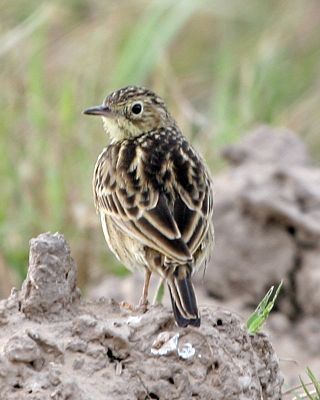
The yellowish pipit is a species of bird in the family Motacillidae. It is found in Argentina, Bolivia, Brazil, Chile, Colombia, French Guiana, Guyana, Panama, Paraguay, Peru, Suriname, Uruguay, and Venezuela. Its natural habitats are temperate grassland, subtropical or tropical seasonally wet or flooded lowland grassland, and pastureland.

The glacier finch, also known as the white-winged diuca finch and glacier bird, is a species of bird in the tanager family Thraupidae.
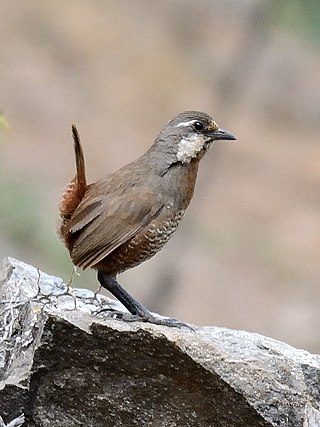
The moustached turca is a passerine bird which is endemic to Chile and belongs to the tapaculo family Rhinocryptidae. Common names of this species include "Turco" or "Turca". It is a terrestrial bird that burrows its nest on steep hillsides and uses flight for short distances. It is not threatened, yet it is unfortunately an understudied species of bird.

The brown-chested martin is a species of passerine bird in the swallow family.

The chestnut-throated huet-huet is a large passerine bird of the family Rhinocryptidae. At an average mass of 165 grams (5.8 oz), it is, with the related black-throated huet-huet, the largest rhinocryptid and the third-heaviest tracheophone suboscine behind the giant and great antpittas. It is a stockily-built bird, averaging 23 centimetres (9.1 in) in length with a predominantly dark brown plumage except for a dark red throat and a pale buff bar on its wind – lacking in the black-throated species. For many decades intense debate existed as to whether these two were one species or two, but molecular studies in the 1990s demonstrated that the two species had been separated since before the Patagonian Ice Sheet first formed in southern Chile.

The chestnut thrush is a species of bird in the family Turdidae. It breeds in the western Himalayas and central/southwestern China; it winters in Eastern Himalaya and northern Southeast Asia. Its natural habitat is temperate forests.

Maulino forest is a forest type naturally growing in the Chilean Coast Range of Central Chile from latitude 35°55 to 36°20 S. The forest grows in the transition zone between Mediterranean climate and humid temperate climate. Precipitation varies from 1000 to 700 mm/a and is concentrated in winter. According to geographers Humberto Fuenzalida and Edmundo Pisano the forest is one of mesophytes on the transition zone of temperate rain forests.























